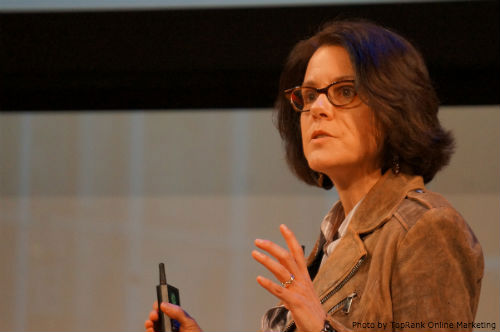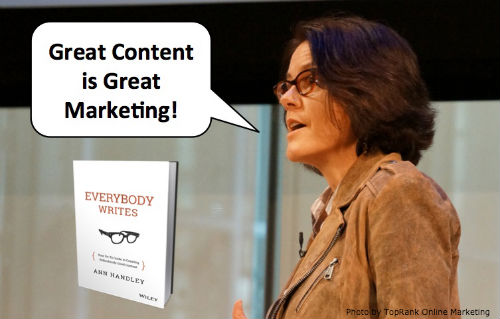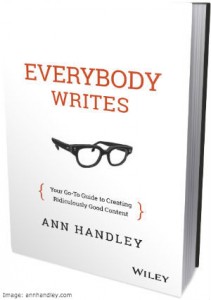
The bell has rung and class is in session.
The topic? Creating content. In particular, ridiculously good content.
Your professor for this essential business skill is none other than Ann Handley, Chief Content Officer of MarketingProfs, the largest marketing community on the web. During the incredibly busy week that was Content Marketing World, Ann took the time to exceed my expectations (once again) and shine her bright light of wisdom on the power of good writing.
In business and in life, writing is an essential part of communications – no matter how digital, virtual and science fiction we get in our communications. That’s why Ann’s new book launching today, Everybody Writes: Your Go-To Guide to Creating Ridiculously Good Content, is so timely. From Twitter to White Papers to books in print, Ann has smart, actionable advice for us all.
Let’s get to it. Ann, are you ready to talk about creating ridiculously good content? Please pick 6 of the following questions to answer:
Sure… grab some pops and nachos and hang over here for a few. You ask. I’ll answer.
What do you love about writing?
I don’t particularly LOVE writing – it’s hard work, and I’m slow at it. ? But I love to read good writing. And I love to have written!
And more generally: I do love the way the process of writing forces a deeper clarity of thought and an empathy for the reader: What am I trying to say really? Am I making this crystal clear for the person I’m trying to reach?
So writing is thinking. And for us as marketers, good writing is good marketing, too: Because when we swap places with our readers during that editing, we are getting inside our customer’s heads to figure out what will matter to them. To create content with meaning for them.
Intellectually, it makes all the sense in the world to create meaningful content. At the same time, the ADD generation is decidedly short form when it comes to writing. A great example is that almost no one live-blogs at conferences anymore, they “live tweet.” How can we get millennials excited about writing again?
Well, isn’t tweeting writing? The words we use on Twitter matter as much as the words we use anywhere else.
Writing doesn’t have to be long to be meaningful. I’d argue that the words we use everywhere – on our websites, on our landing pages, on our LinkedIn profiles and so on – are just as important as the words we use in places we typically think of as “writing.”
Our words are our ambassadors – they tell the world who we are no matter where they appear. And that’s true whether they appear in a tweet, or in this answer right here, right now….
With 28 writing rules in Part 1 of Everybody Writes, it can seem overwhelming to a mediocre writer like myself. What are 3 of the most important writing rules you can recommend so that people like me can write better?
The last thing I wanted to do was produce a writing guide that was as impenetrable and heavy as a swimming pool full of wet cement. And truly, those “rules” are more like bumpers on a bowling lane than hard and fast rules – and in that spirit I encourage any Content McGyvers out there to break them as they wish!
But if I had to choose three: I’d suggest these:
- Shed high school rules. (There really is no one right way to write.)
- Follow a writing GPS. (Having a sense of what path you’re taking makes the journey less anxious.)
- Embrace the Ugly First Draft. Everyone writes badly on a first draft; the key is to be an excellent editor of your own work on subsequent drafts.
Awesomesauce is a Frankenword? Oh the irony! Where do such rules apply when it comes to humor and adding language to conversational content like blogs and social media?
I’m allergic to the word “awesomesauce” and other Frankenwords (like “amazeballs” and “clickability.”) But they bother me less than obese words (almost any word with –ation as a suffix) and jargony “fake words.”
Such words to my ear are the chemical additives of writing – you can use one or two of them sparingly but too many can make you content toxic.
Humor and conversational content is another matter entirely. Most of the content we produce should be conversational – using lots of “yous” and “us” and not so many “our customers” and “the organization.” Corporate-speak like that makes you sound off-putting and impersonal in this post Cluetrain Manifesto-era.
What are some of the most common grammar and usage rules you see being broken with business content?
Part of me doesn’t want to answer this, on the grounds that too many people equate writing with grammar, when it’s so much more than that.
Writing is more about thinking and creating great content experiences for your reader, customer or user. That’s why the “grammar” stuff in the book is second – because in my mind while grammar is important, it’s secondary to the idea, the message and the writing itself.
But since you asked so nicely… and because I like you: I’d say the most common errors I’ve noticed in 25 (!) years of editing business people and marketers are these:
1. Wordiness. Both in specific words (why use “at which time” when you might say “when”?) as well as indulgent, bloated blog posts and other longer-form content. Writing with stylish economy is a gift you can give your readers.
2. Using this/that and these/those when the antecedent isn’t clear. I see this ALL THE TIME. Especially at the beginning of the sentence. This drives me nuts. (What drives me nuts? The sentence? The usage? The question? See what I mean?)
Please name 3 ways a company can get to know their audience better to inform content topics?
Is this the sixth question? I’ve lost count. And you said to answer only six. Anyway, I like that you say “please.” It a small gesture, but it’s nice.
So, as for the answer: certainly getting out and talking to people is key. A lot of marketers I know rarely talk to customers – very often, only customer service or sales does. So, ask customers what they think. Watch how they behave. Look for patterns. I do this via social platforms, too: Twitter is a great listening tool, but many companies use it to listen only for sales opportunities or (worse) they use it to broadcast only.
Pay attention to context as well. Avoid grouping customers in an artificial setting like a focus group. Instead, meet them in their natural habitat so you can get a better sense of how they interact with your content and your site and whatever it is that you do or sell.
And finally: Be a natural skeptic of your own work. Ask So what? about every piece of content you create – and then answer it with a Because. Ask/answer until you uncover the true value for a customer. Why does this matter to them? Why should they care? I wrote a bit more about that here. http://www.marketingprofs.com/articles/2014/25986/writing-gps-for-ridiculously-good-content
What’s the balance between content that empathizes with the customer and content that communicates information to help prospects to buy? We should be able to do both, right?
Those two things are the same thing, to me. The best content answers the questions that customers have – or might have if they knew enough to ask.
So content that helps people make important decisions about their lives is a kind of gift you can give your customers or prospects. The key is to take your product or service out of the starring role – and let it play the supporting role of helping the customer.
The best content marketing isn’t about what you do or what you sell – it’s about how what that thing does for others. That’s a subtle shift, but an important one, and a hard one for companies to truly embrace. (And I say that with love in my heart and with no judgment. I get it.)
What is brand journalism and when does it make sense for a business to include that approach with their content marketing and communications?
Some companies are looking toward traditional journalism to fill the gaping content maw; they are hiring those trained in J-school tactics, such as reporting and storytelling, as in-house brand journalists. A brand journalist or corporate reporter works inside the company, writing and producing videos, blog posts, photos, webinars, charts, graphs, e-books, podcasts, and other information that delivers value to your market.
In short, brand journalists bring a reporter’s sensibility to your content—an editorial approach to building a brand.
That approach is especially useful when we all need to place the needs of our audience first and rise above our corporate-centric messaging. Journalists’ innate understanding of audience means that every time they sit down at their desks to create content, a little voice in the back of their head reminds them: Nobody has to read this. That kind of pressure on your content-creation efforts can only benefit your brand and enhance your integrity.
With so many different platforms, people and situations, is there really such a thing as universal rules guiding the ideal length for blog posts and social media updates?
Ah, you’re referring to Part V: Things Marketers Write. It is one of the more prescriptive parts of the book, so here’s what I’d say:
There is no way one to write, just as there is no one way to parent a child or roast a turkey. (And that’s true of writing social media updates, too.) But there are terrible ways of doing all three things.
So in Part V I’m offering a starting point for companies who aren’t sure where to begin writing a Facebook page update or LinkedIn profile or blog post or landing page or how to use hashtags… or the like.
As I said, Content McGyvers can feel free to toss this section entirely – it’s a section I considered NOT including in the book, because the general approach in the previous four sections confers enough guidance, I thought. But ironically Part V is the section many marketers seem to dig, based on early feedback.
So what do I know? Is there more salsa?
How do you suggest marketers organize writing differently for each social channel? Is it a single idea written different ways or different ideas per channel?
I think it’s more important for marketers to adopt a point-of-view; a clear voice. And then, adapt it to the audiences on those channels.
What are 3 of your favorite content tools? What do you use daily?
I use Word and WordPress daily. But calling them content “tools” is a little like calling underwear part of your OOTD. Technically, yes. But no one really calls out the basics.
I also regularly use Instagram (my own, as a source of content images) and Scrivener, for longer content projects like books and ebooks. That’s four. Oops. I’m terrible at math. Clearly.
What content tool do you wish existed now (but doesn’t)? What would it do?
Hmm. Good question. I already invented blogging.
And I wish I invented Instagram. But alas.

Any future predictions on the state of “content marketing” in the next 5 years? Hot or not?
HOT. Or actually…. Let’s not say HOT. Because that implies a fad, a trend, a passing fancy.
Let’s just say that great content is great marketing. And that will be more true in the next five years than it is now. Which is to say – VERY!
I just realized I answered all of these, didn’t I? See “bad at math” comment, again.
Thanks Ann!
You can get more information on Ann’s soon to be best-seller Everybody Writes on the book website or just go to Amazon or BN and buy it. I did.



